- Calendar
- Online Ticket Sales
- Access
- JA
- EN
A Toast to the Drinking Glass―In History and Life
11 September to 10 November 2013
*There will be an exhibition change during the course of exhibition
Offerings
Glass was first made about 5,000 years ago, in Western Asia, Egypt, and Mycenae, on Crete, an island in the Aegean Sea. Today the word “glass” is associated with transparency, but the earliest glass was an opaque material. Lustrous, easy to work when heated, ancient glass was made to resemble lapis lazuli, turquoise, and other precious stones. Like those precious stones, glass was used for ornaments worn by pharaohs, funerary goods, and other very special purposes.
The production of glass vessels began in Mesopotamia and Egypt in about the sixteenth century BCE. During Egypt’s 18th Dynasty (1570 BCE), glass vessels produced under the patronage of the royal family were used as gifts to powerful persons. The footed cup of core-formed glass (cat. no. 1) in this exhibition is one example. Given to a member to the nobility, it was doubtless cherished and may have had ritual uses.
Wine and other alcoholic beverages have long been part of exalted occasions, washing away pollution and enhancing rulers' power. The patella cup (so called because it is shaped like a kneecap), cat. no. 3, was a holy vessel for serving sacred wine to the gods. Millefiori glass, its name derived from the Italian for “thousand flowers,” does look like a thousand flowers in bloom. Such works beauty expressed reverence for the gods.
When transparent glass began to be made from about the eighth century BCE, its transparency opened up a new dimension: enjoying the sight of the contents of the glass. Perhaps that is why vessels that had been made of metal or clay were replaced by glass vessels. For example, the rhyton terminating in a lion’s head (cat. no. 2) was a vessel designed for pouring liquids; through it, a liquid filled with animal power would be offered to the gods or the king during rituals.
This first section of the exhibition introduces wine vessels used in offerings to exalted beings.
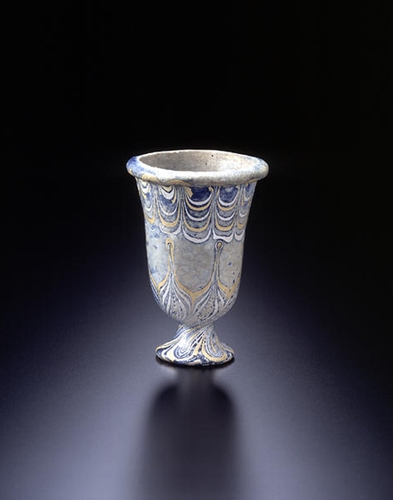
Core-glass Footed Cup
Egypt
14th century BC
Miho Museum, Shiga
Conversations
In ancient Greece, the symposium was an opportunity to drink together after dinner and on into the night while discussing ideas, dreams, and philosophy.
In Greece, where the production and appreciation of wine and the resulting wine culture had been spreading from the thirteenth century BCE, it was customary to drink wine diluted with water. Thus, a variety of types and shapes of wine vessels were created, including vessels for mixing wine and water, ewers, wine cups, and storage and shipping containers. Pottery vessels, however, were dominant in Grecian wine vessels.
From the mid second century BCE, Grecian wine culture reached ancient Rome, where it swiftly spread in the next century. That expansion coincided with a turning point in the history of glass, the invention of glassblowing, probably in the Syria-Palestine region of the Roman Empire in about 50 BCE. Blowing into a gather of glass spooled onto one end of the blowpipe inflates it, permitting the formation of a vessel. This new technique permitted working glass much more swiftly than any of the glassmaking techniques in use earlier and brought glass from the exclusive domain of powerful elites to the lives of ordinary people. The invention of the pointil or punty rod soon followed the invention of glassblowing. A solid metal rod tipped with a wad of hot glass, it is applied to the base of the piece being worked, making it simpler to work the mouth of a vessel or add handles, making possible a great variety of forms.
As glassblowing developed, the many forms of Greek pottery drinking vessels influenced the forms of glass vessels. A splash glass footed cup (cat. no. 31) is thought to have been modeled on the Greek krater, a vessel used to mix wine and water. A bowl with cut decoration (cat. no. 25) was based on a phiale (a Greek term for a shallow cup used as a drinking vessel or libation bowl). A pitcher with handle (cat. no. 35) recalls the form of the oenochoe, a Greek vessel used to pour wine.
Section two of this exhibition offers a glimpse of the glass vessels that inherited or were influenced by the forms of drinking vessels used at Greek symposia and other sociable occasions.
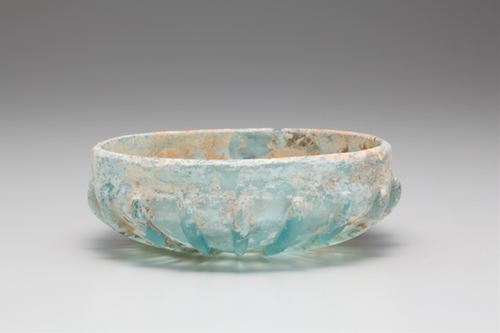
Ribbed Bowl
Eastern Mediterranean
1st century BC-1st century AD
Suntory Museum of Art, Tokyo
(Tsuji Seimei Collection)
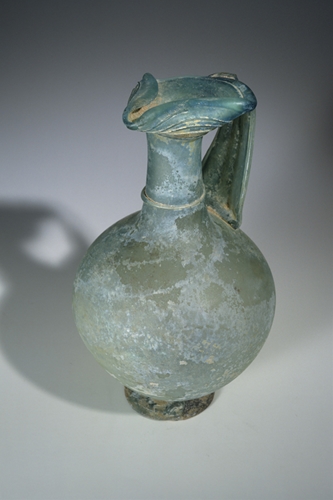
Pitcher with Handle
Eastern Mediterranean
4th century
Okayama Orient Museum, Okayama
Vows
Wine is enjoyed for its bouquet and flavor, of course, and is also indispensable, now as in the past, in situations when a pledge or oath is being made. It was also the custom to drink wine in turn from the same cup, to confirm relationships of trust. The German Daumen glass (cat. no. 40) was a large drinking vessel; all the members of a community would drink wine from it an expression of their commitment to harmonious coexistence. Among friends, people would also drink together as a prayer for or pledge of mutual affection and tranquility. A double stirrup cup (cat. no. 45), used in wishing for a safe return and confirming mutual friendship before a friend set off on a trip, and goblets with angel motifs (cat. no. 42 and 43) with the word “friendship” inscribed in them were among examples of such drinking glasses. Throughout the world, it is customary during wedding ceremonies to drink together and vow eternal love. The Bohemian tiered goblet with birds and animals motifs (cat. no. 46) is a two-tiered nuptial goblet: wine was poured into it and the groom drank from the lower tier and the bride the upper one. Similarly, in Japan, the bride and groom carry out a three-times-three exchange of nuptial cups. The sets of three tiered cut-glass sake cups with stand that may be used on such occasions are beautiful examples of cut glass. In this example (cat. no. 51), the stand is hollow, so that any sake left undrunk can be disposed of in it. While alcoholic beverages were part of weddings in both cases, the volume of drink involved varied with the country. The difference in the size of the vessels is astonishing.
Pledges are not always carried out between human beings. The silver-colored mug with stag design (cat. no. 41) is a beer mug decorated with images of faith and allegiance to God.
Section three introduces drinking vessels and the context of pledges of love, common destiny, and loyalty in which they were used.
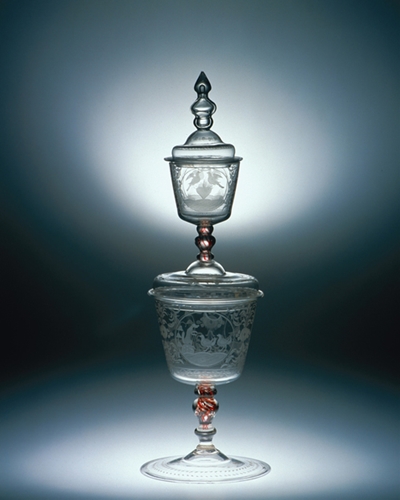
Tiered Goblet with Birds and Animals Design
Bohemia 18th century
Suntory Museum of Art, Tokyo
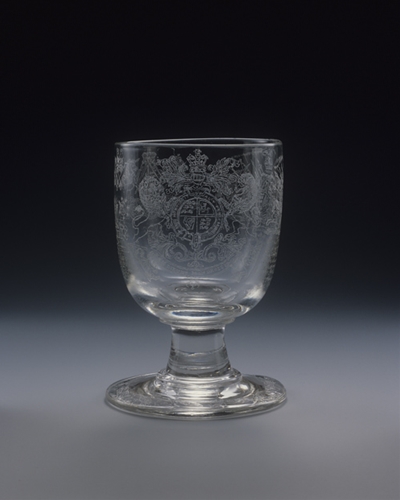
Freemasonry Goblet
England
1868
Takahata Arts and Crafts Museum, Chiba
Glorifications
With the development of improved materials for glassmaking and progress in decorative techniques, greater freedom of form emerged. Even among vessels with the form of wine goblets, for example, examples with a variety of implicit messages appeared. The vessel type known as Holy Roman Emperor and Electors Humpen (cat. no. 63-66), for example, were beer glasses, designed for drinking in turn from the same glass. They are decorated with a double-headed eagle design, the seven electors who chose the Holy Roman Emperor, and other symbols of the Holy Roman Empire. Their role was to encourage and enhance attachment and allegiance to the empire, in a region constantly best by internal strife. Similarly, in Britain, which became the central player in the international economy in the eighteenth century, goblets (such as cat. no. 79) were made with inscriptions of scenes expressing that glory. We also see inscribed on them, as in this example, the phrase "Floreat London," with its hope for continued prosperity. Drinking vessels were often made with such extraordinary techniques that their very use was a status symbol. The Venetian lace glass goblet with lid (cat. no. 54), with lace motifs formed within the glass, was a type of large goblet highly popular among the European aristocracy. Rather than being actually used as a wine glass, such works were adornments for the table, conveying the owner’s lofty status to others. Goblets decorated with hunting scenes, a popular type, had a similar function. Scenes of fox hunting, a sport reserved for the royalty and aristocracy, informed others of the owner’s membership in those ranks of society. The fourth section of this exhibition offers an extensive view of drinking vessels designed to encourage moral or political ideas or to express one’s pride and status.
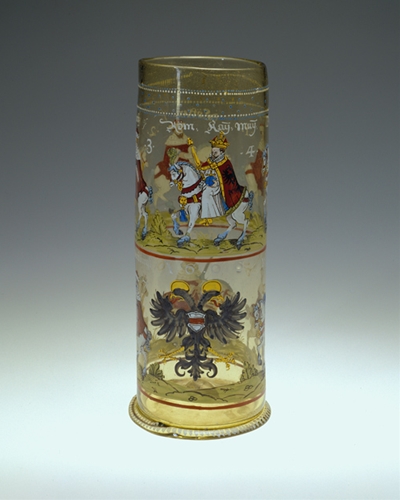
Holy Roman Electors Humpen
Germany
1606
Ishikawa Prefectural Museum of Art
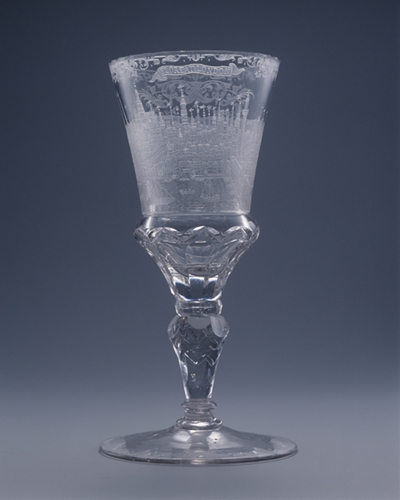
Celebrations
Wine implies a party. Throughout the world, ceremonial annual events and festive banquets are accompanied by wine, and by the clinking together of wine glasses as an auditory component. Vessels for simply enjoying wine, to add to the visual spectacle at a formal banquet, to use at outdoor parties and create a sense of refreshing coolness--goblets and other wine vessels, in great variety, are party animals.
Romer cups from Germany and the Netherlands take their name, it is said, from a word meaning “welcome.” Such cups were used on ordinary occasions to serve wine or beer. The example with "Ein Glasj van welkomest" (a welcoming glass) carved in beautiful ornamental lettering (cat. no. 112), however, probably was used in celebrating the arrival of a special guest.
Events were people gather and enjoy themselves often are accompanied by games and other forms of entertainment. A puzzle goblet (cat. no. 116), for example, requires great ingenuity to figure out how to drink from it. Vessels with two cups attached (cat. no. 117) were designed for a man and woman to drink wine from together. A cantir (cat. no. 118) is a drinking vessel with no mouth; the wine is poured from its spout into the drinker’s mouth. These vessels bring to mind laughing voices and scenes of enjoyment.
Given glass’s cool texture and appearance, it is a popular choice for summer banquets. Sets of sake decanters, tiered sets of boxes, small dishes, and other items fit in boxes designed to be carried to outdoor feasts. The boxes were often of lacquer, but sometimes the box itself was also made of glass (cat. no. 131). The clear, clean effect of the glass evokes a sense of refreshing coolness and brings a suggestion of fresh breezes to hot summer parties.
The final section of this exhibition introduces drinking vessels in conjunction with celebrations, gatherings, hospitality, and sheer enjoyment from all over the world. It also introduces the drinking glass of today through the work of six now active glass artists.
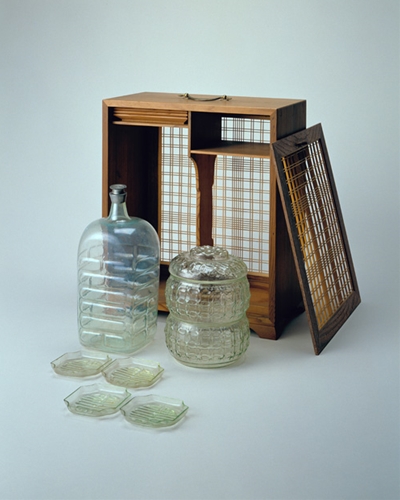
Picnic Box with Glass Saké Bottle, Two-tiered Food Box, and Dishes
Japan
18th century
Bindeisha Vidro-Diamante-Glass Museum, Ehime
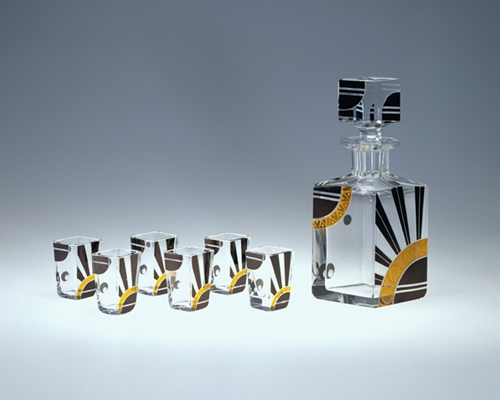
Set of Liqueur Glasses with Geometrical Design Austria
c. 1920
Ishikawa Prefectural Museum of Art
*Unauthorized reproduction or use of texts or images from this site is prohibited.
2025 January
- Exhibition
- Closed
- Tea Ceremony
- Mon
- Tue
- Wed
- Thu
- Fri
- Sat
- Sun
- 1
- 2
- 3
- 4
- 5
- 6
- 7
- 8
- 9
- 10
- 11
- 12
- 13
- 14
- 15
- 16
- 17
- 18
- 19
- 20
- 21
- 22
- 23
- 24
- 25
- 26
- 27
- 28
- 29
- 30
- 31
2025 February
- Exhibition
- Closed
- Tea Ceremony
- Mon
- Tue
- Wed
- Thu
- Fri
- Sat
- Sun
- 1
- 2
- 3
- 4
- 5
- 6
- 7
- 8
- 9
- 10
- 11
- 12
- 13
- 14
- 15
- 16
- 17
- 18
- 19
- 20
- 21
- 22
- 23
- 24
- 25
- 26
- 27
- 28
2025 March
- Exhibition
- Closed
- Tea Ceremony
- Mon
- Tue
- Wed
- Thu
- Fri
- Sat
- Sun
- 1
- 2
- 3
- 4
- 5
- 6
- 7
- 8
- 9
- 10
- 11
- 12
- 13
- 14
- 15
- 16
- 17
- 18
- 19
- 20
- 21
- 22
- 23
- 24
- 25
- 26
- 27
- 28
- 29
- 30
- 31
2025 April
- Exhibition
- Closed
- Tea Ceremony
- Mon
- Tue
- Wed
- Thu
- Fri
- Sat
- Sun
- 1
- 2
- 3
- 4
- 5
- 6
- 7
- 8
- 9
- 10
- 11
- 12
- 13
- 14
- 15
- 16
- 17
- 18
- 19
- 20
- 21
- 22
- 23
- 24
- 25
- 26
- 27
- 28
- 29
- 30
2025 May
- Exhibition
- Closed
- Tea Ceremony
- Mon
- Tue
- Wed
- Thu
- Fri
- Sat
- Sun
- 1
- 2
- 3
- 4
- 5
- 6
- 7
- 8
- 9
- 10
- 11
- 12
- 13
- 14
- 15
- 16
- 17
- 18
- 19
- 20
- 21
- 22
- 23
- 24
- 25
- 26
- 27
- 28
- 29
- 30
- 31
2025 June
- Exhibition
- Closed
- Tea Ceremony
- Mon
- Tue
- Wed
- Thu
- Fri
- Sat
- Sun
- 1
- 2
- 3
- 4
- 5
- 6
- 7
- 8
- 9
- 10
- 11
- 12
- 13
- 14
- 15
- 16
- 17
- 18
- 19
- 20
- 21
- 22
- 23
- 24
- 25
- 26
- 27
- 28
- 29
- 30
2025 July
- Exhibition
- Closed
- Tea Ceremony
- Mon
- Tue
- Wed
- Thu
- Fri
- Sat
- Sun
- 1
- 2
- 3
- 4
- 5
- 6
- 7
- 8
- 9
- 10
- 11
- 12
- 13
- 14
- 15
- 16
- 17
- 18
- 19
- 20
- 21
- 22
- 23
- 24
- 25
- 26
- 27
- 28
- 29
- 30
- 31
2025 August
- Exhibition
- Closed
- Tea Ceremony
- Mon
- Tue
- Wed
- Thu
- Fri
- Sat
- Sun
- 1
- 2
- 3
- 4
- 5
- 6
- 7
- 8
- 9
- 10
- 11
- 12
- 13
- 14
- 15
- 16
- 17
- 18
- 19
- 20
- 21
- 22
- 23
- 24
- 25
- 26
- 27
- 28
- 29
- 30
- 31
2025 September
- Exhibition
- Closed
- Tea Ceremony
- Mon
- Tue
- Wed
- Thu
- Fri
- Sat
- Sun
- 1
- 2
- 3
- 4
- 5
- 6
- 7
- 8
- 9
- 10
- 11
- 12
- 13
- 14
- 15
- 16
- 17
- 18
- 19
- 20
- 21
- 22
- 23
- 24
- 25
- 26
- 27
- 28
- 29
- 30
2025 October
- Exhibition
- Closed
- Tea Ceremony
- Mon
- Tue
- Wed
- Thu
- Fri
- Sat
- Sun
- 1
- 2
- 3
- 4
- 5
- 6
- 7
- 8
- 9
- 10
- 11
- 12
- 13
- 14
- 15
- 16
- 17
- 18
- 19
- 20
- 21
- 22
- 23
- 24
- 25
- 26
- 27
- 28
- 29
- 30
- 31
2025 November
- Exhibition
- Closed
- Tea Ceremony
- Mon
- Tue
- Wed
- Thu
- Fri
- Sat
- Sun
- 1
- 2
- 3
- 4
- 5
- 6
- 7
- 8
- 9
- 10
- 11
- 12
- 13
- 14
- 15
- 16
- 17
- 18
- 19
- 20
- 21
- 22
- 23
- 24
- 25
- 26
- 27
- 28
- 29
- 30
2025 December
- Exhibition
- Closed
- Tea Ceremony
- Mon
- Tue
- Wed
- Thu
- Fri
- Sat
- Sun
- 1
- 2
- 3
- 4
- 5
- 6
- 7
- 8
- 9
- 10
- 11
- 12
- 13
- 14
- 15
- 16
- 17
- 18
- 19
- 20
- 21
- 22
- 23
- 24
- 25
- 26
- 27
- 28
- 29
- 30
- 31
2026 January
- Exhibition
- Closed
- Tea Ceremony
- Mon
- Tue
- Wed
- Thu
- Fri
- Sat
- Sun
- 1
- 2
- 3
- 4
- 5
- 6
- 7
- 8
- 9
- 10
- 11
- 12
- 13
- 14
- 15
- 16
- 17
- 18
- 19
- 20
- 21
- 22
- 23
- 24
- 25
- 26
- 27
- 28
- 29
- 30
- 31
2026 February
- Exhibition
- Closed
- Mon
- Tue
- Wed
- Thu
- Fri
- Sat
- Sun
- 1
- 2
- 3
- 4
- 5
- 6
- 7
- 8
- 9
- 10
- 11
- 12
- 13
- 14
- 15
- 16
- 17
- 18
- 19
- 20
- 21
- 22
- 23
- 24
- 25
- 26
- 27
- 28
2026 March
- Exhibition
- Closed
- Mon
- Tue
- Wed
- Thu
- Fri
- Sat
- Sun
- 1
- 2
- 3
- 4
- 5
- 6
- 7
- 8
- 9
- 10
- 11
- 12
- 13
- 14
- 15
- 16
- 17
- 18
- 19
- 20
- 21
- 22
- 23
- 24
- 25
- 26
- 27
- 28
- 29
- 30
- 31
2026 April
- Exhibition
- Closed
- Mon
- Tue
- Wed
- Thu
- Fri
- Sat
- Sun
- 1
- 2
- 3
- 4
- 5
- 6
- 7
- 8
- 9
- 10
- 11
- 12
- 13
- 14
- 15
- 16
- 17
- 18
- 19
- 20
- 21
- 22
- 23
- 24
- 25
- 26
- 27
- 28
- 29
- 30
2026 May
- Exhibition
- Closed
- Mon
- Tue
- Wed
- Thu
- Fri
- Sat
- Sun
- 1
- 2
- 3
- 4
- 5
- 6
- 7
- 8
- 9
- 10
- 11
- 12
- 13
- 14
- 15
- 16
- 17
- 18
- 19
- 20
- 21
- 22
- 23
- 24
- 25
- 26
- 27
- 28
- 29
- 30
- 31
2026 June
- Exhibition
- Closed
- Mon
- Tue
- Wed
- Thu
- Fri
- Sat
- Sun
- 1
- 2
- 3
- 4
- 5
- 6
- 7
- 8
- 9
- 10
- 11
- 12
- 13
- 14
- 15
- 16
- 17
- 18
- 19
- 20
- 21
- 22
- 23
- 24
- 25
- 26
- 27
- 28
- 29
- 30
2026 July
- Exhibition
- Closed
- Mon
- Tue
- Wed
- Thu
- Fri
- Sat
- Sun
- 1
- 2
- 3
- 4
- 5
- 6
- 7
- 8
- 9
- 10
- 11
- 12
- 13
- 14
- 15
- 16
- 17
- 18
- 19
- 20
- 21
- 22
- 23
- 24
- 25
- 26
- 27
- 28
- 29
- 30
- 31
2026 August
- Exhibition
- Closed
- Mon
- Tue
- Wed
- Thu
- Fri
- Sat
- Sun
- 1
- 2
- 3
- 4
- 5
- 6
- 7
- 8
- 9
- 10
- 11
- 12
- 13
- 14
- 15
- 16
- 17
- 18
- 19
- 20
- 21
- 22
- 23
- 24
- 25
- 26
- 27
- 28
- 29
- 30
- 31
2026 September
- Exhibition
- Closed
- Mon
- Tue
- Wed
- Thu
- Fri
- Sat
- Sun
- 1
- 2
- 3
- 4
- 5
- 6
- 7
- 8
- 9
- 10
- 11
- 12
- 13
- 14
- 15
- 16
- 17
- 18
- 19
- 20
- 21
- 22
- 23
- 24
- 25
- 26
- 27
- 28
- 29
- 30
2026 October
- Exhibition
- Closed
- Mon
- Tue
- Wed
- Thu
- Fri
- Sat
- Sun
- 1
- 2
- 3
- 4
- 5
- 6
- 7
- 8
- 9
- 10
- 11
- 12
- 13
- 14
- 15
- 16
- 17
- 18
- 19
- 20
- 21
- 22
- 23
- 24
- 25
- 26
- 27
- 28
- 29
- 30
- 31
2026 November
- Exhibition
- Closed
- Mon
- Tue
- Wed
- Thu
- Fri
- Sat
- Sun
- 1
- 2
- 3
- 4
- 5
- 6
- 7
- 8
- 9
- 10
- 11
- 12
- 13
- 14
- 15
- 16
- 17
- 18
- 19
- 20
- 21
- 22
- 23
- 24
- 25
- 26
- 27
- 28
- 29
- 30
2026 December
- Exhibition
- Closed
- Mon
- Tue
- Wed
- Thu
- Fri
- Sat
- Sun
- 1
- 2
- 3
- 4
- 5
- 6
- 7
- 8
- 9
- 10
- 11
- 12
- 13
- 14
- 15
- 16
- 17
- 18
- 19
- 20
- 21
- 22
- 23
- 24
- 25
- 26
- 27
- 28
- 29
- 30
- 31
